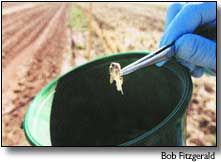|
October 2, 2001
By Janelle Holden They’re almost all dead by now, but September’s glut of brown "miller" moths hovered around porch lights and pressed their little bodies up against screen doors, pestering anyone in their path. More than just a pesky nuisance for homeowners, the largest family of moths —the noctuids— can harm almost any crop and garden plant. Two of the area’s most common types of noctuid moths are pale western and army cutworms. When cutworms hatch into larvae in the soil they can damage budding spring crops by "cutting" the plants at ground level. "The cutworms can damage almost any crop. They emerge at night and will cut the plant off at the soil line," explained Tom Hooten. Hooten, a research assistant at the Colorado State University Yellow Jacket research station, is trapping and counting pale western and cutworm moths in conjunction with research projects in Montana, South Dakota, Wyoming, Nebraska and Idaho. From the numbers of moths trapped, researchers can develop cutworm forecasts for the next spring, valuable information for farmers with crops at risk. Moths lay their eggs in crop soils in the fall, so the number of larvae eating spring plants can be predicted by the number of live moths trapped in the fall. Hooten says that since Aug. 20, when they began trapping, the number of pale western cutworms trapped has come close to exceeding the number of moths that crops can handle next spring without suffering a significant loss. Sept. 17 was the peak day for moths, when 139 pale westerns were trapped. Last week less than 50 were trapped, and trapping will end this week. Army cutworms will likely not be a threat, since the numbers trapped are far below the estimated economic threshold. However, the prediction is only good, Hooten warns, for the crop area he is monitoring, an area 30 feet by 30 feet downwind from the pheromone traps. "The numbers can’t be applied to another area. Each field should be monitored individually," said Hooten. Damage from cutworm larvae can often be confused with plant winterkill. Any crop damage assessment, Hooten advised, should include a cutworm survey, which means hunting for cutworm larvae underground in the early spring, and estimating how many are nesting in the soil per foot of crop row. "Larvae are relatively easy to kill; the trick is getting them early enough," said Hooten. Weather conditions, temperature, moisture, predation, crops, pest and host plant interaction all figure into the number of larvae in the soil come spring. For worried gardeners who have seen a larger number of moths than usual this fall, Hooten advises protecting spring buds with a pop can, cut in half, and covering the plant. Pale western and army cutworms are virtually indistinguishable to the naked eye, but the sex pheromones researchers use as bait attract only the male of the species. In general, however, each moth is light brown with indistinct dark markings. "The variation in coloring on each species can be quite large," said Hooten, who observed that army cutworms tend to be darker, and a little more streamlined at rest. |
||
|
Copyright © 2001 the Cortez
Journal. All rights reserved. |
